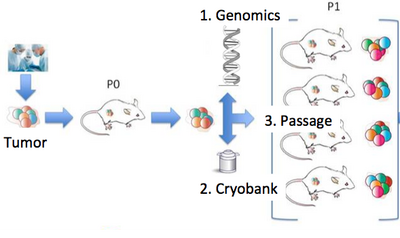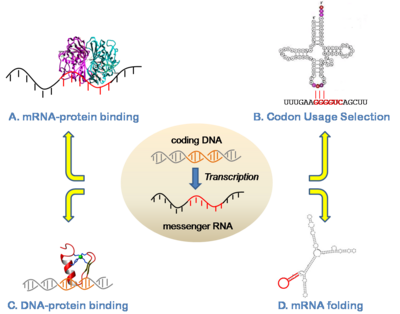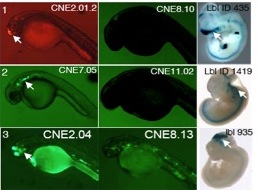Difference between revisions of "Research Topics"
| Line 5: | Line 5: | ||
Since joining JAX, our lab has worked on cancer using patient-derived xenografts, a model system in which human tumors are engrafted and studied in NSG mice. JAX has developed >300 such models from cancer types including breast, lung, bladder, and others, and these are a [http://tumor.informatics.jax.org/mtbwi/pdxSearch.do community wide resource]. As of 2017, our lab co-leads the Data Coordination Center for the NCI [https://www.pdxnetwork.org/ PDXNet], a multi-institute consortium supported by the NCI Cancer Moonshot Initative. We are partnering with institutes around the country including the Huntsman Cancer Institute, Baylor College of Medicine, MD Anderson, Washington University, the Wistar Institute, NCI's Frederick National Laboratory, and Seven Bridges Genomics to jointly study cancer using xenografts. Our lab is involved in many studies using these to understand the genetic drivers of cancer and drug resistance, with a focus on computational modeling of intratumoral evolution (Noorbakhsh and Chuang 2017). | Since joining JAX, our lab has worked on cancer using patient-derived xenografts, a model system in which human tumors are engrafted and studied in NSG mice. JAX has developed >300 such models from cancer types including breast, lung, bladder, and others, and these are a [http://tumor.informatics.jax.org/mtbwi/pdxSearch.do community wide resource]. As of 2017, our lab co-leads the Data Coordination Center for the NCI [https://www.pdxnetwork.org/ PDXNet], a multi-institute consortium supported by the NCI Cancer Moonshot Initative. We are partnering with institutes around the country including the Huntsman Cancer Institute, Baylor College of Medicine, MD Anderson, Washington University, the Wistar Institute, NCI's Frederick National Laboratory, and Seven Bridges Genomics to jointly study cancer using xenografts. Our lab is involved in many studies using these to understand the genetic drivers of cancer and drug resistance, with a focus on computational modeling of intratumoral evolution (Noorbakhsh and Chuang 2017). | ||
| − | Within JAX we work closely with a number of groups studying cancer with xenografts and clincial samples, including the Liu, Bult | + | Within JAX we work closely with a number of groups studying cancer with xenografts and clincial samples, including the Liu, Bult, Lee, Palucka, Robson, and Anczukow-Camarda labs, on projects such as triple negative breast cancer (Menghi et al 2016), gastric cancer (Cho et al 2018), and immune cell activity (Bais et al 2017; Chae et al 2018). The lab also has interests in ecological modeling of cancer and development of predictors of cancer outcome using neural networks. |
[[File:400px-Pdx.png]] | [[File:400px-Pdx.png]] | ||
Revision as of 05:51, 5 June 2018
Broad advances in DNA sequencing have radically transformed the scale and nature of genetics making it possible to analyze genomic changes across species, individuals, cell-types, and as mutations accrue and are subject to natural selection. Diverse phenotypic datasets have also grown rapidly, not only for sequencing-based assays such as gene expression and protein-nucleic acid interactions, but also other types including metabolomic, clinical, and drug-screening data. My lab is interested in computational and mathematical approaches to analyzing such large data sources to understand how genomes function and evolve and to make these findings clinically relevant. We develop and use techniques from a variety of disciplines, including statistical inference, molecular evolution and biophysical modeling. We are currently focused in two major areas: 1) Cancer Evolution and Patient-Derived Xenografts, and 2) RNA-Level Gene Regulation. These projects involve collaborations with experimental and computational colleagues at JAX Genomic Medicine, JAX Mammalian Genetics, and a number of outside groups.
Cancer GenomicsSince joining JAX, our lab has worked on cancer using patient-derived xenografts, a model system in which human tumors are engrafted and studied in NSG mice. JAX has developed >300 such models from cancer types including breast, lung, bladder, and others, and these are a community wide resource. As of 2017, our lab co-leads the Data Coordination Center for the NCI PDXNet, a multi-institute consortium supported by the NCI Cancer Moonshot Initative. We are partnering with institutes around the country including the Huntsman Cancer Institute, Baylor College of Medicine, MD Anderson, Washington University, the Wistar Institute, NCI's Frederick National Laboratory, and Seven Bridges Genomics to jointly study cancer using xenografts. Our lab is involved in many studies using these to understand the genetic drivers of cancer and drug resistance, with a focus on computational modeling of intratumoral evolution (Noorbakhsh and Chuang 2017).
Within JAX we work closely with a number of groups studying cancer with xenografts and clincial samples, including the Liu, Bult, Lee, Palucka, Robson, and Anczukow-Camarda labs, on projects such as triple negative breast cancer (Menghi et al 2016), gastric cancer (Cho et al 2018), and immune cell activity (Bais et al 2017; Chae et al 2018). The lab also has interests in ecological modeling of cancer and development of predictors of cancer outcome using neural networks.
Our lab studies gene regulation at both the RNA and DNA levels. For RNA, our projects have included regulation of translation, protein-RNA binding, and splicing. For example, in collaboration with Prof. Susan Ackerman (UCSD) we have identified and characterized a mutation in a tRNA as a driver for neurodegeneration and shown that this phenotype is mediated by specific translational pausing at the codons complementary to the tRNA anticodon (Ishimura et al 2014; Ishimura et al 2016). This was the first tRNA mutation found to have a phenotypic consequence in a mammal. Another current interest is how proteins interact with RNAs to achieve specific binding. In this area, we have developed approaches to identify functional elements in RNA based on functional genomic, structural, algorithmic, and high-throughput sequencing approaches (Dotu et al 2018; Zarringhalam et al 2012). Our lab has been studying the functions and neutral evolutionary behavior of synonymous sites in coding sequences for more than a decade (Chuang and Li 2004; Chin et al 2005). We have shown for example that coding sequences are replete with binding sites for microRNAs, as well as other types of functional sequences such as exonic splicing enhancers. Such sites exhibit a strong selective pressure on the synonymous sites of coding regions (Kural et al 2009; Ding et al 2012; Ritter et al 2012).
Our lab also studies 3D chromosome structure (Grzeda et al 2014) from ChIA-PET data in collaboration with the lab of Yijun Ruan.
Much of the lab's research has grown out of early interests in molecular evolution and statistical physics. For example, we have characterized the relative importance of cis- and trans- regulatory evolution on enhancers (Ritter et al 2010; Persampieri et al 2008; http://chuanglabapps.jax.org/chuanglab/cneBrowser/ http://chuanglabapps.jax.org/chuanglab/cneViewer/ )
A related interest has been the evolution of mutational processes across species and cancers. This has included research into why mutation rates are uniform in some species, such as the sensu stricto yeasts, while rates vary by location in other species, such as mouse and human (Fox et al 2008; Chuang and Li 2004; Chuang and Li 2007; Chin, Chuang, and Li 2005). Biophysics interests have included the dynamics of translocation of a polymer through a nanopore (Chuang et al, Phys Rev E 2001) and the thermodynamic stability of protein folds (Chuang et al, Phys Rev Lett 2001).



